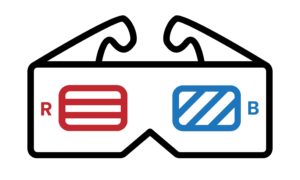The Complexity Space Framework™ (CSF) is how we make the case that linear models of change are helpful, but insufficient, to address the complexity of modern organizations. We introduced the CSF as a more appropriate paradigm for understanding and influencing systemic change based on the principles of nonlinear sciences like complexity and chaos theory. Like linear models, we recognized that the CSF alone, while helpful, is also not sufficient to continually y address the changing requirements of internal and external stakeholders.
 We introduced the concept of “Both-And” to argue that a dynamic combination of practices that apply both linear and complex maximize the chances for short- and long-term success. Our visual metaphor was 3–D glasses. Seen through the red lens (linear), the world looks one way. Seen through the blue lens (complex), it looks like another. Viewed simultaneously through both, something totally different emerges.
We introduced the concept of “Both-And” to argue that a dynamic combination of practices that apply both linear and complex maximize the chances for short- and long-term success. Our visual metaphor was 3–D glasses. Seen through the red lens (linear), the world looks one way. Seen through the blue lens (complex), it looks like another. Viewed simultaneously through both, something totally different emerges.
A recent “aha” is that the “Both” in “Both-And” implies a range of only two choices — “this” and/or “that.” Subsequent conversations evolved around the constant impact of time, language, environmental change, social media, and a myriad of other things on individuals, teams, organizations, and societies. While the above examples of influences on any ecosystem, could be integrated as part of a conversation about the four ecosystem dimensions (history, context, culture, motivation) that are always present, always interacting with each other, and always changing, we believe a more expansive recognition of these — and many other forces like them, warrants a broader catch-phrase.
“All-And” is our new verbal shorthand for this recognition. It encompasses the red and blue lenses of linear and non-linear concepts of change, yet acknowledges and invites more broad-ranging conversations about the things that matter in a given change situation. Understanding these distinctions individually and collectively provides a powerful lens for understanding a complex system’s past as well as its present condition.
The visual metaphor changes from 3-D glasses to a kaleidoscope. Turning the linear knob one way and the non-linear knob the other, an infinite number of combinations emerges. The light entering the kaleidoscope changes the image. How far the kaleidoscope is held from the eye changes the image. Fatigue, ability to distinguish color variations, eye-hand coordination …all blend together to create a view that is different for every person and that changes over time.
By making “All-And” part of discussions that seek to build capacity and collaboration, all participants are invited into a different engagement about “how we got here,” and how do we discover the next smart step toward sustainable change.
